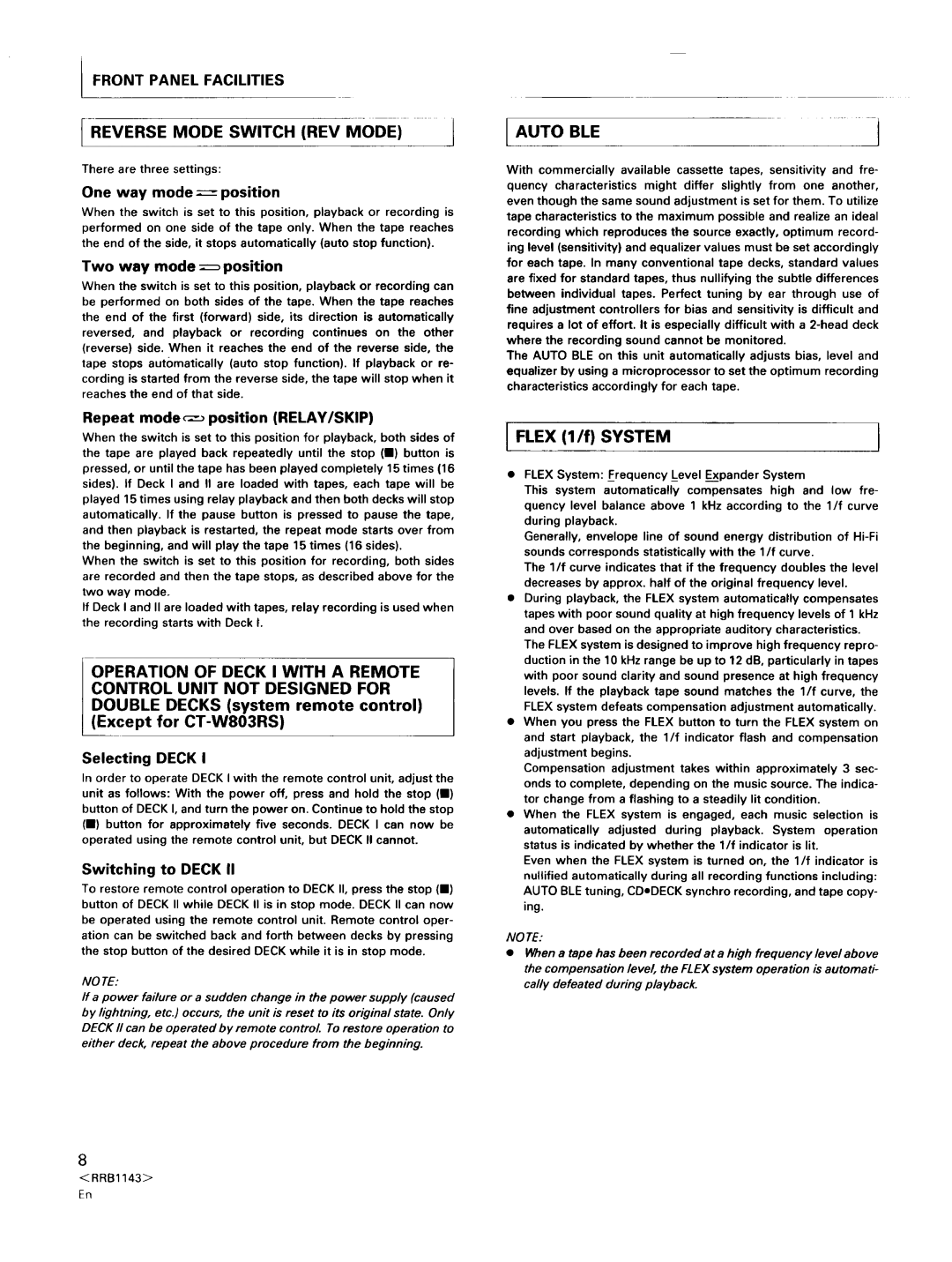FRONT PANEL FACILITIES
REVERSE MODE SWITCH (REV MODE)
There are three settings:
One way mode z position
When the switch is set to this position, playback or recording is
performed on one side of the tape only. When the tape reaches
the end of the side, it stops automatically (auto stop function).
Two way mode _-_position
When the switch is set to this position, playback or recording can
be performed on both sides of the tape. When the tape reaches
the end of the first (forward) side, its direction is automatically
reversed, and playback or recording continues on the other
(reverse) side. When it reaches the end of the reverse side, the
tape stops automatically (auto stop function). If playback or re- cording is started from the reverse side, the tape will stop when it reaches the end of that side.
Repeat modec--=-_ position (RELAY/SKIP)
When the switch is set to this position for playback, both sides of
the tape are played back repeatedly until the stop (i) button is
pressed, or until the tape has been played completely 15 times (16 sides). If Deck I and II are loaded with tapes, each tape will be played 15 times using relay playback and then both decks will stop
automatically. If the pause button is pressed to pause the tape, and then playback is restarted, the repeat mode starts over from
the beginning, and will play the tape 15 times (16 sides).
When the switch is set to this position for recording, both sides are recorded and then the tape stops, as described above for the two way mode.
If Deck I and II are loaded with tapes, relay recording is used when the recording starts with Deck L
OPERATION OF DECK I WITH A REMOTE CONTROL UNIT NOT DESIGNED FOR
DOUBLE DECKS (system remote control) (Except for CT-W803RS)
Selecting DECK I
In order to operate DECK I with the remote control unit, adjust the unit as follows: With the power off, press and hold the stop (i) button of DECK I, and turn the power on. Continue to hold the stop
(11)button for approximately five seconds. DECK I can now be operated using the remote control unit, but DECK I! cannot.
Switching to DECK II
To restore remote control operation to DECK II, press the stop (e) button of DECK II while DECK II is in stop mode. DECK II can now be operated using the remote control unit. Remote control oper-
ation can be switched back and forth between decks by pressing the stop button of the desired DECK while it is in stop mode.
NO TE:
If a power failure or a sudden change in the power supply (caused
by lightning, etc.) occurs, the unit is reset to its original state. Only
DECK II can be operated by remote control To restore operation to
either deck, repeat the above procedure from the beginning.
8
<RRB1143>
En
With commercially available cassette tapes, sensitivity and fre- quency characteristics might differ slightly from one another, even though the same sound adjustment is set for them. To utilize tape characteristics to the maximum possible and realize an ideal recording which reproduces the source exactly, optimum record- ing level (sensitivity) and equalizer values must be set accordingly for each tape. In many conventional tape decks, standard values are fixed for standard tapes, thus nullifying the subtle differences between individual tapes. Perfect tuning by ear through use of fine adjustment controllers for bias and sensitivity is difficult and requires a lot of effort. It is especially difficult with a 2-head deck where the recording sound cannot be monitored.
The AUTO BLE on this unit automatically adjusts bias, level and equalizer by using a microprocessor to set the optimum recording characteristics accordingly for each tape.
•FLEX System: Frequency Level Expander System
This system automatically compensates high and low fre- quency level balance above 1 kHz according to the 1/f curve during playback.
Generally, envelope line of sound energy distribution of Hi-Fi sounds corresponds statistically with the 1/f curve.
The 1If curve indicates that if the frequency doubles the level decreases by approx, half of the original frequency level.
•During playback, the FLEX system automatically compensates tapes with poor sound quality at high frequency levels of 1 kHz and over based on the appropriate auditory characteristics. The FLEX system is designed to improve high frequency repro- duction in the 10 kHz range be up to 12 dB, particularly in tapes with poor sound clarity and sound presence at high frequency levels. If the playback tape sound matches the 1/f curve, the FLEX system defeats compensation adjustment automatically.
•When you press the FLEX button to turn the FLEX system on and start playback, the 1/f indicator flash and compensation adjustment begins.
Compensation adjustment takes within approximately 3 sec- onds to complete, depending on the music source. The indica- tor change from a flashing to a steadily lit condition.
•When the FLEX system is engaged, each music selection is automatically adjusted during playback. System operation status is indicated by whether the 1/f indicator is lit.
Even when the FLEX system is turned on, the 1/f indicator is nullified automatically during all recording functions including: AUTO BLE tuning, CDeDECK synchro recording, and tape copy- ing.
NO TE:
•When a tape has been recorded at a high frequency level above the compensation level, the FLEX system operation is automati- cally defeated during playback.

